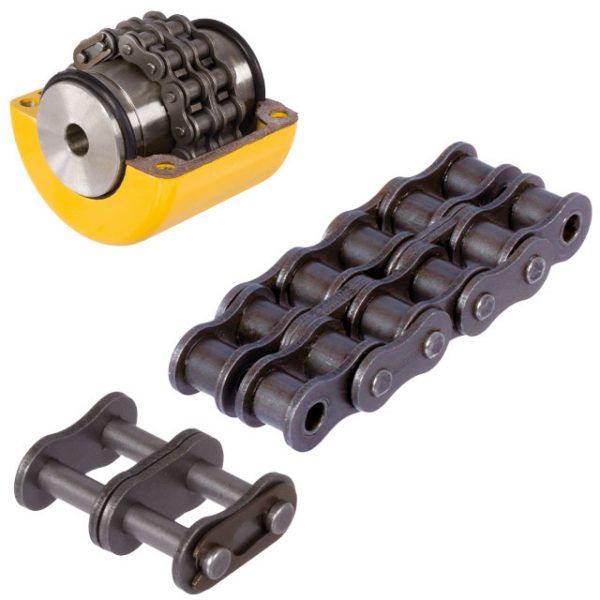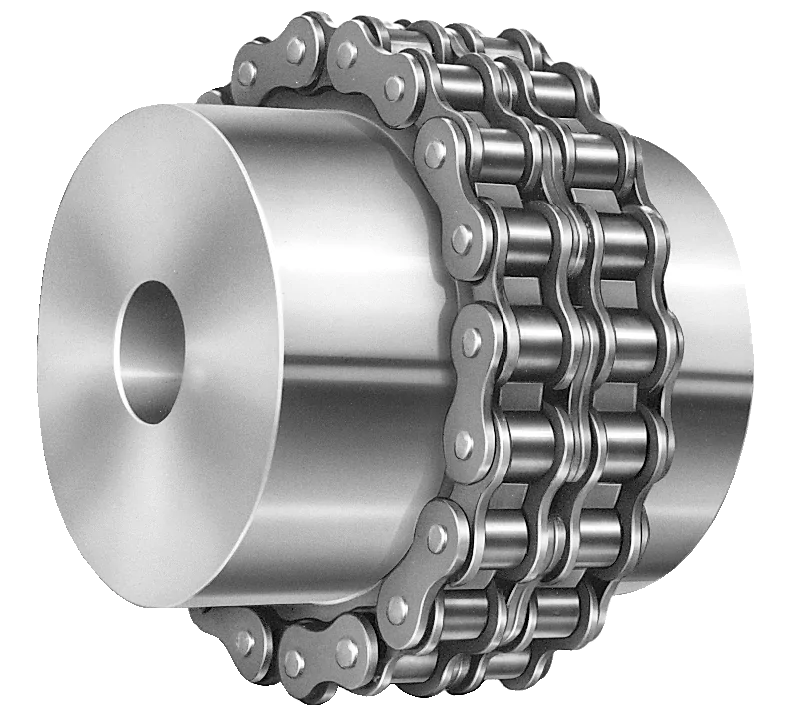Product Description
JJ is a leading provider of dependable, high-quality power transmission products for customers. One of our facilities focuses on manufacturing chain coupling, curved-tooth coupling, claw-type coupling, and disc-type coupling. We’re available to make customers satisfied. We also comply with customers requirements OEM-embranced.
| ITEM NO. | TORGUE | PLAIN BORE |
MAX. BORE |
BUSH LENGTH |
BUSH DIA |
BORE OF CENTER |
D | DH | L | E | T | T | S | A | C | ADJUST. NUT |
ADJUST. BOLT |
SET SCREW |
WEIGHT | |||
| kgf-m | mm | mm | mm | mm | mm | mm | mm | mm | mm | mm | mm | mm | mm | mm | kg | |||||||
| TL200-1 | 0.3-1 | 7.0 | 14.0 | 3.8 | 30 | -0.571 | 30 | .+0.03 | 50.0 | 24.0 | 29.0 | 6.5 | 2.6 | 2.5 | 7.0 | 38.0 | M24 P1.0 |
0.2 | ||||
| TL200-2 | 0.7-2 | -0.049 | 0 | |||||||||||||||||||
| TL250-1 | 0.7-2.8 | 10.0 | 22.0 | 4.5 | 41 | -0.571 | 41 | .+0.05 | 65.0 | 35.0 | 48.0 | 16.0 | 4.5 | 3.2 | 9.0 | 4.0 | 50.0 | M35 P1.5 |
M5 | 0.5 | ||
| TL250-2 | 1.4-5.5 | -0.045 | 0 | |||||||||||||||||||
| TL350-1 | 2.0-7.6 | 17.0 | 25.0 | 6.5 | 49 | -0.571 | 49 | .+0.05 | 89.0 | 42.0 | 62.0 | 19.0 | 4.5 | 3.2 | 16.0 | 6.0 | 63.0 | M42 P1.5 |
M6 | 1.2 | ||
| TL350-2 | 3.5-15.2 | -0.065 | 0 | |||||||||||||||||||
| TL500-1 | 4.8-21.4 | 20.0 | 42.0 | 6.5 | 74 | -0.050 | 74 | .+0.05 | 127.0 | 65.0 | 76.0 | 22.0 | 5.7 | 3.2 | 16.0 | 7.0 | M65 P1.5 |
M8 P1.0 3 PCS |
M8 | 3.0 | ||
| TL500-2 | 9.0-42.9 | -0.100 | 0 | |||||||||||||||||||
| TL700-1 | 11.8-58.1 | 30.0 | 64.0 | 9.5 | 105 | -0.075 | 105 | .+0.05 | 178.0 | 95.0 | 98.0 | 24.0 | 7.7 | 3.2 | 29.0 | 8.0 | M95 P1.5 |
M10 P1.5 3 PCS |
M10 | 6.7 | ||
| TL700-2 | 22.8-110.6 | -0.125 | 0 | |||||||||||||||||||
| TL100-16 | 40-130 | 30.0 | 72.0 | 12.5 | 135 | -0.085 | 135 | .+0.07 | 254.0 | 100.0 | 115.0 | 23.0 | 15.0 | 4.0 | 24.0 | 19.0 | M18 P1.5 3 PCS |
21.0 | ||||
| TL100-24 | 60-190 | -0.125 | -0.125 | |||||||||||||||||||
| TL140-10 | 90-272 | 40.0 | 100.0 | 15.5 19.5 23.5 |
183 | -0.070 | 183 | .+0.07 | 356.0 | 145.0 | 150.0 | 31.0 | 13.0 | 4.0 | 29.0 | 27.0 | M26 P1.5 3 PCS |
52.0 | ||||
| TL140-15 | 200-400 | -0.120 | 0 | |||||||||||||||||||
| TL240-6 | 250-500 | 50.0 | 130.0 | 15.5 19.5 23.5 |
226 | -0.070 | 226 | .+0.07 | 508.0 | 185.0 | 175.0 | 36.0 | 15.0 | 4.0 | 31.0 | 36.0 | M32 P1.5 3 PCS |
117.0 | ||||
| TL240-12 | 470-950 | -0.120 | 0 | |||||||||||||||||||

Can chain couplings be used in high-speed applications?
Chain couplings can be used in certain high-speed applications, but there are limitations and considerations that need to be taken into account. The suitability of chain couplings for high-speed applications depends on factors such as the specific design of the coupling, the chosen chain type, and the operating conditions. Here are some key points to consider:
- Coupling Design: The design of the chain coupling plays a crucial role in determining its suitability for high-speed applications. High-speed chain couplings typically incorporate features that minimize vibration, reduce stress concentrations, and ensure smooth operation. Couplings designed for high-speed use may have additional balancing or damping mechanisms to counteract potential issues associated with centrifugal forces and resonance.
- Chain Type: The type of chain used in the coupling can affect its performance at high speeds. In general, roller chains are commonly used in chain couplings. However, for high-speed applications, special high-speed roller chains or other chain types designed for increased rotational speeds may be required. These chains are designed to minimize friction, reduce wear, and handle the centrifugal forces associated with high-speed operation.
- Bearing Selection: Proper bearing selection is critical for high-speed chain couplings. The bearings used in the coupling should be capable of handling the anticipated speeds and dynamic loads. High-quality, precision bearings with appropriate lubrication are typically necessary to ensure smooth operation and minimize the risk of premature failure.
- Balancing and Vibration: High-speed chain couplings should be properly balanced to minimize vibration and ensure stable operation. Imbalances in rotating components can lead to increased noise, excessive stress, and reduced service life. Balancing techniques such as dynamic balancing or the use of counterweights may be employed to achieve smooth and reliable operation.
- Lubrication: Adequate lubrication is crucial for high-speed chain couplings to minimize friction, reduce wear, and dissipate heat effectively. Proper lubrication practices, including the use of high-quality lubricants and regular maintenance, should be followed to ensure optimal performance and prevent premature failure.
Despite these considerations, it’s important to note that chain couplings may have practical limitations in terms of maximum allowable speeds. The specific speed limitations will depend on factors such as the coupling design, chain type, size, and the operating conditions. It is advisable to consult the manufacturer’s specifications and guidelines to determine the maximum recommended speed for a particular chain coupling.
In certain high-speed applications where chain couplings may not be suitable, alternative coupling types such as flexible disc couplings, gear couplings, or elastomeric couplings specifically designed for high-speed applications may be more appropriate. These couplings are engineered to handle the challenges associated with high rotational speeds, offering improved balance, reduced vibration, and higher speed capabilities.
Overall, when considering the use of chain couplings in high-speed applications, it is essential to carefully evaluate the specific requirements, consult with the manufacturer, and ensure that the coupling is designed and selected to operate safely and reliably at the desired speeds.

What are the maintenance requirements for chain couplings?
Maintaining chain couplings is essential for their reliable and efficient operation over time. Regular maintenance helps prevent premature wear, reduces the risk of unexpected failures, and prolongs the lifespan of the coupling. Here are some key maintenance requirements for chain couplings:
- Lubrication: Proper lubrication is crucial for the smooth operation of chain couplings. Regularly lubricate the roller chain and sprockets with the recommended lubricant. Follow the manufacturer’s guidelines regarding the type of lubricant to use and the frequency of lubrication. Lubrication helps reduce friction, wear, and noise, and it extends the service life of the coupling.
- Inspection: Regularly inspect the chain coupling for signs of wear, damage, or misalignment. Check the sprockets, roller chain, connecting pins, and bushings or bearings for any abnormalities. Look for worn teeth, elongation of the roller chain, loose or missing fasteners, and excessive play in the coupling. Address any issues promptly to prevent further damage and ensure the coupling’s proper functioning.
- Tension Adjustment: Check the tension of the roller chain regularly. Improper chain tension can lead to premature wear and affect the coupling’s performance. Follow the manufacturer’s guidelines for the correct chain tension and make adjustments as necessary. Proper tension ensures optimal power transmission and helps accommodate misalignments.
- Alignment: Monitor the alignment of the shafts connected by the chain coupling. Misalignment can cause excessive stress on the coupling components and lead to premature failure. If misalignment is detected, take the necessary corrective measures, such as realigning the shafts or using alignment tools. Proper alignment promotes smooth operation and prolongs the life of the coupling.
- Contamination Control: Protect the chain coupling from contamination by keeping the surrounding area clean. Dust, dirt, debris, and moisture can affect the coupling’s performance and accelerate wear. Use appropriate covers or guards to shield the coupling from external contaminants. Regularly clean the coupling and remove any debris that may have accumulated.
- Periodic Replacement: Over time, the components of a chain coupling can experience wear and fatigue. Periodically replace worn or damaged components, such as sprockets, roller chains, connecting pins, and bushings or bearings, with new ones. Follow the manufacturer’s recommended maintenance schedule for component replacement to ensure the coupling’s reliability and prevent unexpected failures.
- Documentation: Maintain proper documentation of the maintenance activities performed on the chain coupling. Keep records of lubrication schedules, inspections, adjustments, and component replacements. This documentation helps track the maintenance history of the coupling and provides valuable information for future reference and troubleshooting.
By following these maintenance requirements, you can ensure the optimal performance, longevity, and reliability of your chain coupling. Regular maintenance minimizes the risk of unexpected downtime, reduces repair costs, and maximizes the efficiency of your machinery or equipment.

What is a chain coupling?
A chain coupling is a mechanical device used to connect two rotating shafts in a power transmission system. It consists of two sprockets or toothed wheels and a roller chain that meshes with the sprocket teeth. The sprockets are mounted on the respective shafts and linked together by the chain, allowing torque to be transmitted from one shaft to the other.
Chain couplings are designed to provide a flexible and reliable connection between shafts while accommodating misalignment between them. They are known for their ability to compensate for angular, parallel, and axial misalignments, making them suitable for a wide range of industrial applications.
The sprockets of a chain coupling typically have hardened teeth that engage with the rollers of the chain. The chain itself is made up of a series of interconnected links, each consisting of two plates joined by pins. The rollers are mounted on the pins, allowing them to rotate freely and mesh with the sprocket teeth.
One of the key advantages of chain couplings is their ability to transmit high torque loads. The engagement between the sprockets and the chain provides a positive drive, allowing for efficient power transfer even in demanding applications. Chain couplings are commonly used in heavy-duty machinery and equipment where large amounts of power need to be transferred, such as conveyors, mixers, crushers, and industrial drives.
Chain couplings also offer flexibility in shaft alignment. They can compensate for angular misalignment, which occurs when the shafts are not perfectly aligned at an angle. Additionally, they can accommodate parallel misalignment, where the shafts are offset from each other, as well as axial misalignment, which refers to the displacement along the axis of the shafts.
Proper lubrication is essential for the efficient operation and longevity of chain couplings. Lubricants such as oil or grease are applied to the chain and sprockets to reduce friction and wear. This helps to prevent heat buildup and ensures smooth rotation and power transmission.
Chain couplings are available in various sizes, configurations, and materials to suit different application requirements. The selection of a chain coupling depends on factors such as torque capacity, speed, shaft diameter, and misalignment tolerance.
In summary, chain couplings provide a flexible, reliable, and high-torque solution for connecting rotating shafts in power transmission systems. They offer the ability to compensate for misalignment, making them suitable for a wide range of industrial applications where efficient power transfer is crucial.


editor by CX 2023-10-08